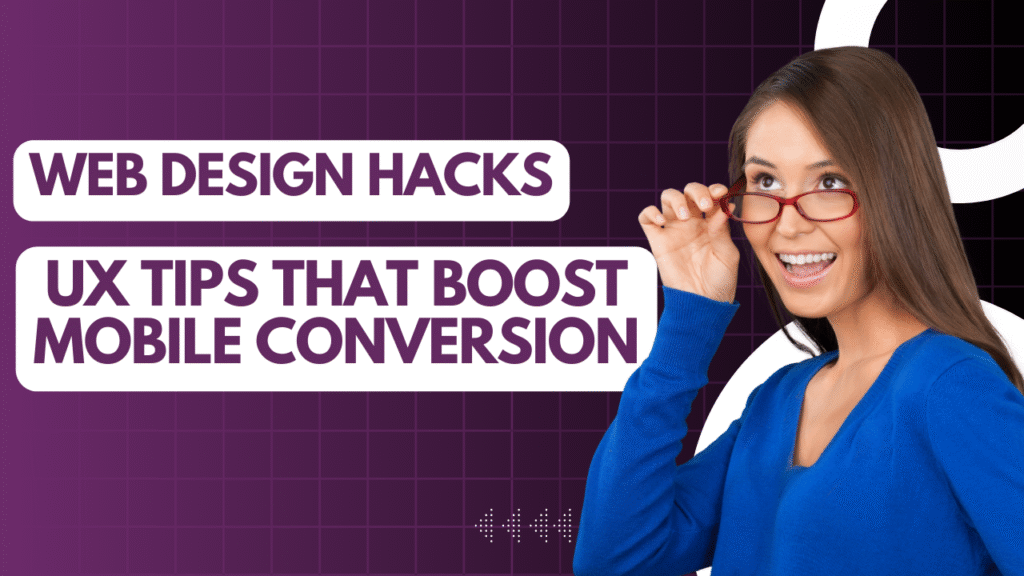
Mobile browsing is no longer optional—it’s the default. More than 60% of global web traffic comes from smartphones, and mobile users expect websites to be fast, seamless, and easy to navigate. If your design doesn’t deliver, they’ll bounce in seconds. That’s where UX tips that boost mobile conversions come into play.
Optimizing user experience (UX) is about reducing friction, guiding users toward action, and creating an enjoyable journey. In this blog, we’ll explore practical design hacks that help businesses improve engagement and maximize conversions on mobile.
1. Prioritize Speed Above Everything
Why It Matters
Mobile users are impatient. A one-second delay in page load time can cut conversions by up to 7%.
Hacks to Implement
- Use image compression tools like TinyPNG or WebP.
- Enable browser caching and use a content delivery network (CDN).
- Keep your code lean—remove unused CSS or scripts.
- Test speed regularly using Google PageSpeed Insights.
The faster your site loads, the more likely users are to stay and buy.
2. Keep Navigation Minimal and Intuitive
Why It Matters
On small screens, complex menus overwhelm users. Mobile UX should feel effortless.
Hacks to Implement
- Use a simple hamburger menu with no more than 5–6 primary options.
- Place high-priority CTAs (“Shop Now,” “Book a Call”) above the fold.
- Add sticky navigation bars for quick access without endless scrolling.
- Use breadcrumb trails for e-commerce sites so users don’t feel lost.
This clear navigation structure ensures users find what they want quickly.
3. Optimize Touch-Friendly Buttons and CTAs
Why It Matters
Fingers are less precise than mouse clicks. Small buttons frustrate users and increase bounce rates.
Hacks to Implement
- Minimum button size: 44px by 44px.
- Use contrasting colors to make CTAs pop.
- Place CTAs in thumb-friendly zones (bottom right for right-hand users).
- Keep CTA text action-oriented: “Get Started,” “Add to Cart,” “Claim Offer.”
By ensuring buttons are easy to tap, you reduce drop-offs at the most critical moments.
4. Use Mobile-First Forms
Why It Matters
Checkout and lead forms are often where conversions drop. Long, clunky forms on mobile create friction.
Hacks to Implement
- Enable autofill and mobile-friendly input types (number keypad for phone fields).
- Break long forms into short, step-by-step processes.
- Add progress bars so users know how many steps remain.
- Provide guest checkout to avoid unnecessary account creation.
Streamlined forms create a smoother path to purchase or signup.
5. Leverage Visual Hierarchy and White Space
Why It Matters
Small screens demand clarity. A cluttered design overwhelms users.
Hacks to Implement
- Use bold headings, larger fonts, and clear section breaks.
- Apply white space strategically to make content easier to scan.
- Keep paragraphs short—3 to 4 lines max.
- Highlight key actions with contrasting colors and icons.
A clean design guides attention naturally and encourages action.
6. Mobile-Optimized Media and Content
Why It Matters
Visuals drive engagement, but oversized or poorly formatted media can destroy mobile UX.
Hacks to Implement
- Use responsive images that resize automatically.
- Compress videos or embed from lightweight players.
- Create bite-sized content with scannable bullet points.
- Add captions for videos since many users browse with sound off.
Smart media usage increases engagement without slowing down performance.
7. Build Trust with Mobile-Friendly Reviews & Social Proof
Why It Matters
Conversions rely on trust. Mobile users need instant reassurance.
Hacks to Implement
- Display customer reviews prominently under product descriptions.
- Use trust badges (secure payment, money-back guarantee).
- Showcase user-generated content (Instagram photos, testimonials).
- Add “people also bought” suggestions for credibility and upsells.
When visitors feel safe and validated, they’re more likely to convert.
8. Test, Measure, and Iterate Constantly
Why It Matters
Mobile UX is not static. User behaviors change, and so should your design.
Hacks to Implement
- Run A/B tests for CTA placements, colors, and layouts.
- Track mobile heatmaps to see where users click or drop off.
- Monitor conversion funnel analytics to identify leaks.
- Use feedback surveys for direct user input.
Continuous optimization ensures your design evolves with user expectations.
Small UX Tweaks, Big Conversion Wins
Mobile UX is no longer a nice-to-have—it’s a must for businesses that want to grow online. By applying UX tips that boost mobile conversions, you create a smoother, more engaging experience that directly impacts your bottom line.
From faster load times and simplified navigation to trust-building reviews and optimized forms, every small tweak adds up. Remember: your website isn’t just a digital storefront—it’s a user journey. Make it one worth completing.

